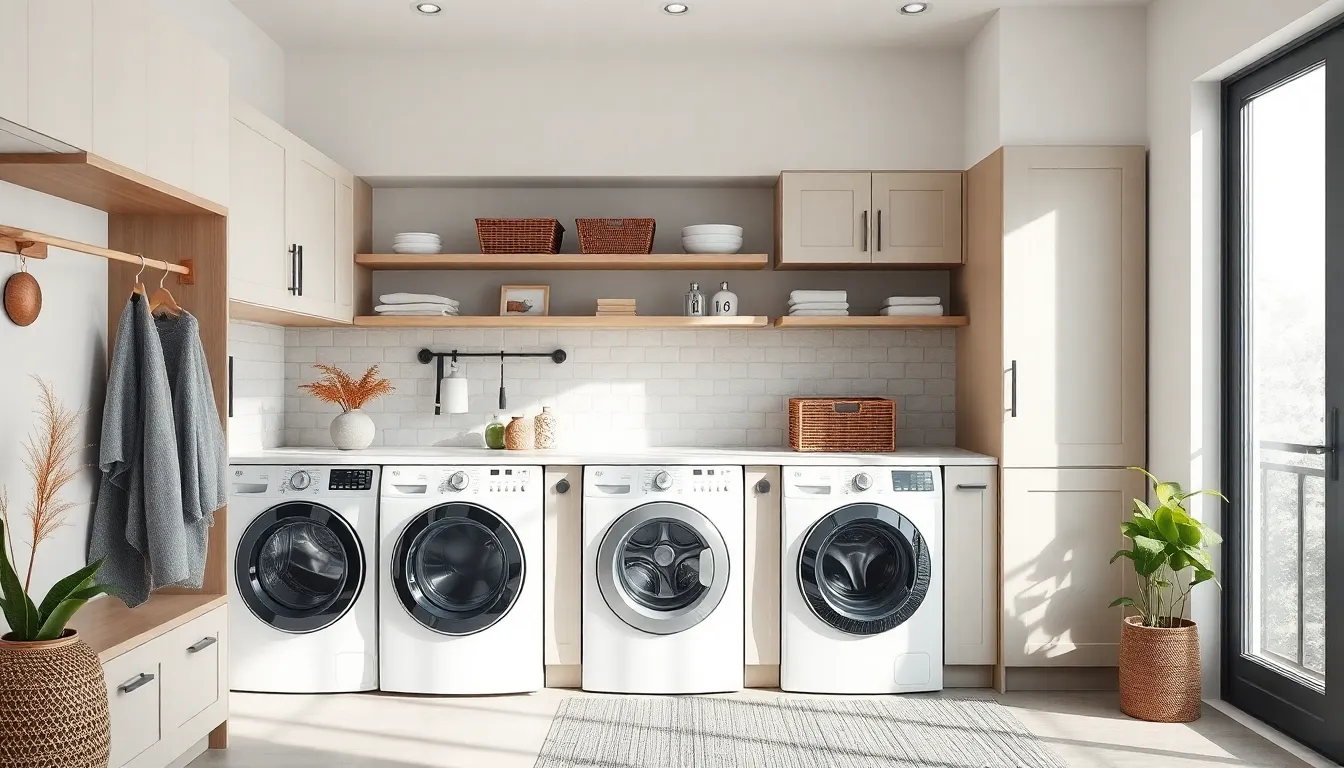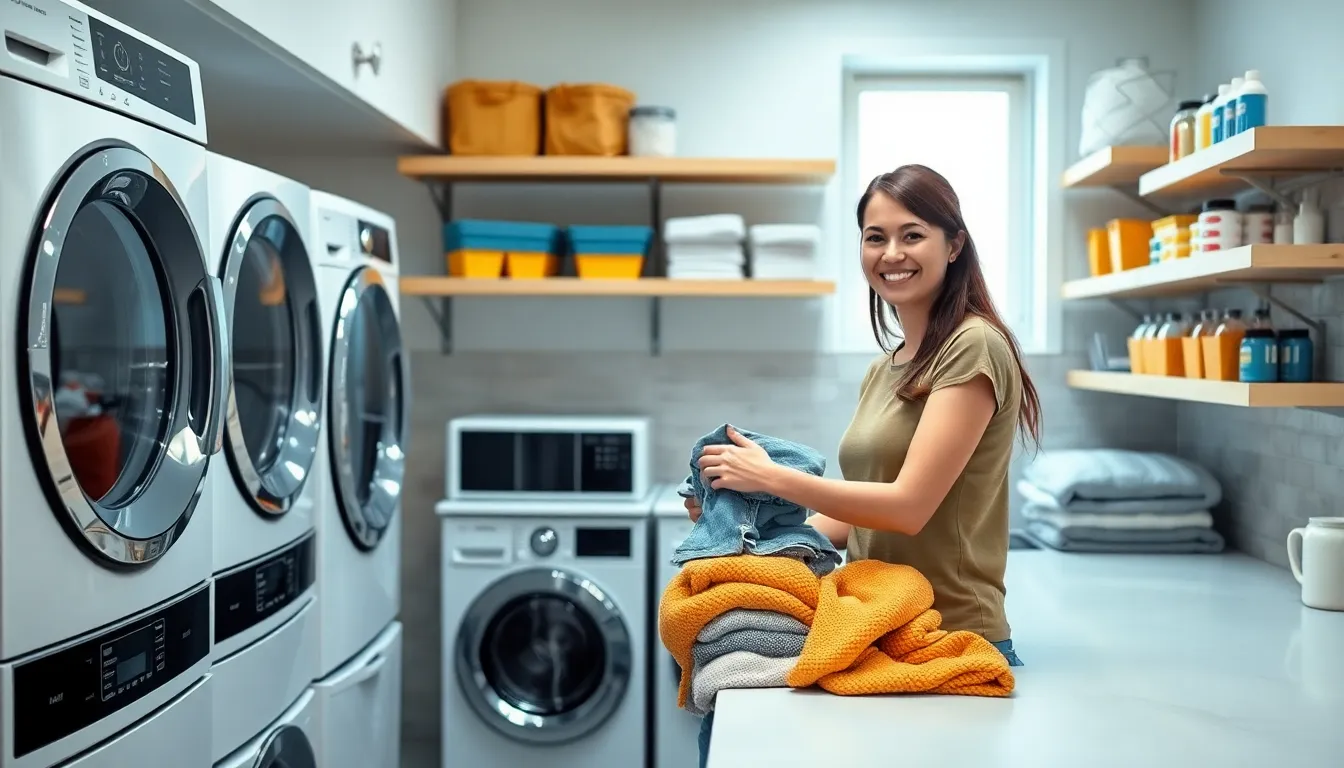Home utility areas often serve as the unsung heroes of household functionality. These spaces, typically tucked away from the main living areas, play a crucial role in maintaining order and efficiency. From laundry rooms to mudrooms, they provide essential support for daily tasks while keeping the rest of the home organized and clutter-free.
Designing an effective utility area can enhance a home’s overall appeal and usability. By maximizing space and incorporating smart storage solutions, homeowners can create a functional environment that meets their specific needs. Whether it’s sorting laundry or managing outdoor gear, a well-planned utility area can transform everyday chores into seamless routines.
Table of Contents
ToggleOverview of Home Utility Areas
Home utility areas play a crucial role in organizing and enhancing the functionality of a household. Spaces such as laundry rooms, mudrooms, and utility closets serve specific purposes that streamline daily tasks.
- Laundry Rooms: Laundry rooms allow for efficient washing, drying, and folding of clothes. They often include essential appliances like washers, dryers, and storage for detergents and linens. Efficient layout design increases accessibility and creates a pleasant environment for chores.
- Mudrooms: Mudrooms provide a dedicated space for transitioning from the outdoors to the indoors. Features like hooks, benches, and shoe storage help manage clutter. Strategically located near entryways, mudrooms contribute to maintaining cleanliness in living areas by preventing dirt and debris from entering.
- Utility Closets: Utility closets serve as storage for cleaning supplies, tools, and other household necessities. Utilizing vertical space with shelving maximizes storage capacity. Proper organization in utility closets simplifies access and ensures that essential items remain readily available.
Maximizing the use of home utility areas through thoughtful design and organization enhances overall household efficiency. Incorporating smart storage solutions improves not only the functionality of these spaces but also contributes to the overall aesthetic of the home. Prioritizing the design of utility areas fosters an organized living environment, making daily routines more manageable.
Importance of Design in Home Utility Areas

Design plays a crucial role in the effectiveness of home utility areas. Well-thought-out spaces enhance both functionality and aesthetic appeal, making everyday tasks simpler and more enjoyable.
Functionality and Efficiency
Functional design maximizes utility areas’ operational potential. Efficient layouts facilitate easy access to appliances and supplies. For instance, placing laundry machines near storage for detergents streamlines the washing process. Incorporating built-in cabinetry and shelving reduces clutter while promoting organization. Dedicated zones for specific tasks, such as sorting or folding clothes, boost productivity. Moreover, optimizing lighting improves visibility, allowing for better task execution. Overall, intentional design choices significantly raise efficiency within these essential spaces.
Aesthetic Considerations
Aesthetic design transforms utility areas from purely functional spaces into attractive extensions of the home. Choosing harmonious color schemes can create a cohesive look throughout the house. Decorative elements, such as artwork or stylish storage solutions, elevate the visual appeal. Using quality materials not only enhances durability but also adds an elegant touch. Incorporating natural light, where possible, makes these areas feel more inviting. Ultimately, an aesthetically pleasing design contributes to overall home value and charm, fostering a positive atmosphere in these frequently used spaces.
Common Types of Home Utility Areas
Home utility areas play crucial roles in enhancing household organization and efficiency. Key types include laundry rooms, mudrooms, and pantry spaces.
Laundry Rooms
Laundry rooms serve as dedicated spaces for washing, drying, and folding clothes. Equipped with washers and dryers, these areas streamline the laundry process. Proper organization through shelves and baskets simplifies the sorting and storing of items. Implementing features such as counter space facilitates folding and ironing. Energy-efficient appliances can improve sustainability while saving on utility costs.
Mudrooms
Mudrooms act as transitional spaces between the outdoors and indoors, keeping the main living areas free of dirt and clutter. These areas typically include storage solutions like hooks for coats, cubbies for shoes, and benches for convenience. Properly designed mudrooms incorporate durable materials to withstand outdoor elements and heavy foot traffic. Adding a designated area for pet supplies can enhance functionality for pet owners.
Pantry Spaces
Pantry spaces provide essential storage for food and supplies, contributing to kitchen organization. Well-structured pantries utilize shelves and bins to categorize items, streamlining meal preparation. Factors such as lighted interiors and clear labeling improve accessibility and ease of use. Incorporating non-perishable storage solutions helps manage inventory effectively and reduces food waste.
Tips for Organizing Home Utility Areas
Organizing home utility areas enhances their functionality and efficiency. Implementing effective strategies significantly improves the usability of spaces like laundry rooms, mudrooms, and pantries.
Storage Solutions
Selecting appropriate storage solutions simplifies organization within utility areas.
- Shelving Units: Use sturdy shelving units to maximize vertical space. Consider adjustable shelves for flexibility.
- Baskets and Bins: Utilize labeled baskets and bins for categorized storage. This approach streamlines the retrieval of items.
- Over-the-Door Organizers: Opt for over-the-door organizers to store frequently used items. This option conserves space and provides easy access.
- Wall Hooks: Install wall hooks for hanging items like coats, bags, or cleaning tools. This keeps surfaces clear and reduces clutter.
- Drawer Dividers: Incorporate dividers in drawers to compartmentalize small items. This method enhances organization in a confined space.
Maximizing Space
Maximizing space in utility areas creates a more functional environment.
- Multi-Functional Furniture: Choose furniture that serves multiple purposes. For instance, a bench with hidden storage increases seating while reducing clutter.
- Pegboards: Install pegboards for flexible and customizable storage. Use hooks to display tools or kitchen utensils, keeping them within reach.
- Vertical Storage: Implement vertical storage solutions like wall-mounted racks or ceiling-mounted systems. This strategy leverages height, freeing up floor space.
- Decluttering Regularly: Schedule regular decluttering sessions to keep areas organized. Dispose of or donate unused items to maintain a streamlined environment.
- Smart Layouts: Plan layouts to optimize flow and accessibility. Create dedicated zones for specific tasks to enhance efficiency in each utility area.
Home utility areas play a crucial role in enhancing the functionality and efficiency of a household. By focusing on the design and organization of spaces like laundry rooms, mudrooms, and pantries, homeowners can create environments that simplify daily tasks.
Incorporating smart storage solutions and efficient layouts not only maximizes space but also elevates the overall aesthetic appeal. These areas become more than just functional spaces; they transform into attractive extensions of the home.
Investing time and effort into these often-overlooked areas ultimately leads to a more organized living environment, contributing to a smoother daily routine and increased home value. Prioritizing utility areas is a smart choice for any homeowner looking to improve their living space.


